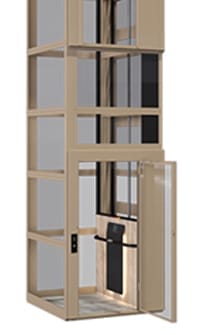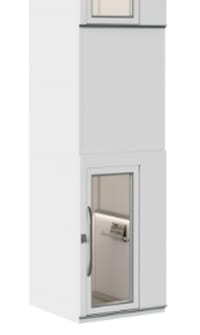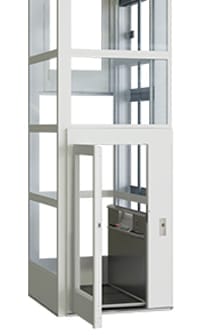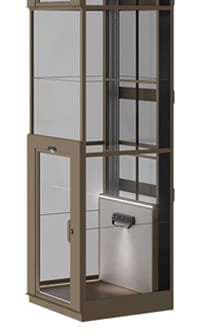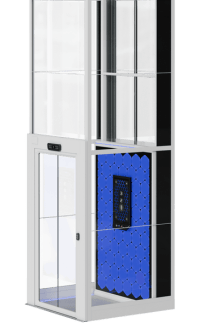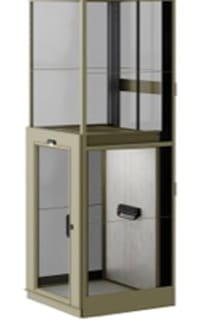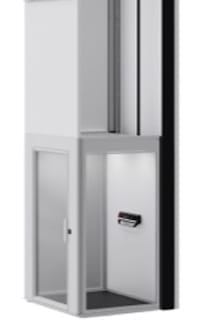The Ultimate Guide to Screw-Driven Home Lifts
Imagine a home lift that doesn’t require a machine room or a deep pit, can be installed in just days, and offers unparalleled safety for your family. That’s the power of a screw-driven home lift. This innovative technology is transforming homes across Thailand, offering a blend of Scandinavian design, cutting-edge engineering, and unmatched convenience.
This guide will walk you through everything you need to know about screw-driven home lifts, from how they work to why they are the smartest choice for your home.
tl;dr: Key Takeaways of Screw-Driven Home Lifts
For those in a hurry, here are the essential facts about screw-driven home lifts:
- What it is: A home lift that uses a simple, robust, and incredibly safe screw-and-nut mechanism to move between floors.
- Best for: Existing homes, townhouses, and any space with limited structural support. It’s the top choice for homeowners prioritizing safety and minimal renovation.
- Key Advantages: Unmatched safety, minimal construction requirements (no pit or machine room), a space-efficient footprint, and remarkably fast installation.
- Installation Time: The entire process can be completed in as little as 4-7 days.
- Cost: While the initial investment is a key consideration, the long-term value is exceptional due to significantly lower maintenance needs and no costly construction.
What is a Screw-Driven Home Lift and How Does it Work?
The technology behind the screw-driven lift is both simple and brilliant, having been trusted for decades as one of the safest lift mechanisms ever designed.
The Simple Genius of the Screw and Nut
At its core, the lift operates on a straightforward principle: a powerful, quiet motor rotates a large threaded screw (like a giant bolt), and the lift car, which is attached to a drive nut, travels smoothly and securely up or down the screw. This direct drive system eliminates the need for complex cables or hydraulic pistons, making it incredibly reliable.
Key Components of a Modern Screw-Driven Lift
- The Screw: A long, threaded steel bar that runs the height of the lift.
- The Drive Nut: Securely attached to the lift platform, it moves along the screw.
- The Motor: A high-efficiency motor (like our EcoSilent system) that turns the screw with whisper-quiet precision.
- The Lift Platform: The cabin you ride in, which can be fully customized to match your home’s interior.
Pros and Cons of Screw-Driven Home Lifts
Every technology has its strengths. A screw-driven system offers overwhelming advantages for home use.
| Pros | Cons |
|---|---|
|
Unmatched Safety No risk of falling |
Slower Speed than commercial elevators |
|
Minimal Structural Impact No pit or machine room |
Lower Weight Capacity than industrial lifts |
|
Space-Saving Design Fits almost anywhere |
Not Ideal for High-Rise Buildings best for low-rise residential homes |
|
Fast & Clean Installation 4–7 days |
|
|
Low Maintenance Needs No oils or cables |
|
|
Energy Efficient Uses household power |
|
|
Quiet Operation with EcoSilent Technology |
Comparison: Screw-Driven vs. Other Lift Technologies
How does a screw-driven lift stack up against older technologies? The difference is clear, especially for residential settings.
Home Lift System Comparison
| Feature | Screw-Driven (Cibes) | Hydraulic | Traction (Sling) | Vacuum |
|---|---|---|---|---|
| Machine Room Needed? | No | Yes | Yes | No |
| Pit Required? | No, or very shallow (50mm) | Yes (deep pit required) | Yes (deep pit required) | No |
| Best For | Existing homes, limited space | Heavy loads, commercial use | High-rise buildings, high speed | 1-2 person use, round shape |
| Installation Time | 5-7 days | Weeks | Weeks | 7 days |
| Safety Risk | Very low (cannot fall) | Risk of oil leaks | Risk of cable snapping (rare) | Power-dependent seal |
| Maintenance | Low | High (oil changes, seals) | Moderate (cable checks) | Moderate (seal checks) |

Why Choose a Screw-Driven Lift for Your Home in Thailand?
Perfect for the Thai Urban Home
The compact, self-contained design is a perfect match for modern townhouses and villas in cities like Bangkok, where space is a premium. It can be installed in several spots, in a stairwell, a corner, or even outdoors without requiring major renovations.
Outdoor setting, withstanding the Climate
Built with high-quality, weather-resistant materials like powder-coated steel and laminated safety glass, our lifts are designed to withstand Thailand’s tropical climate, ensuring long-lasting durability and performance.
Quiet, Clean, and Unobtrusive Installation
We understand that your home is your sanctuary. The installation process is fast, clean, and managed entirely by our certified team, causing minimal disruption to your family’s life.
Frequently Asked Questions on Screw-Driven Home Lifts (FAQ)
Here are answers to the most common questions we receive from homeowners in Thailand.
Q: How safe is a screw-driven home lift?
A: It is the safest technology on the market. The design makes it mechanically impossible for the lift car to fall. All Cibes lifts are certified to Europe’s highest safety standards (EN 81-41) by third party Lift Instituut in the Netherlands and include features like a battery backup for safe lowering during a power outage, safety edges, and an emergency phone.
Q: Does a screw-driven lift require a lot of construction work?
A: No. Because it is self-contained and doesn’t need a separate machine room or a deep pit, the structural modifications to your home are minimal.
Q: How much space do I need for a screw-driven lift?
A: You need surprisingly little space. Our most compact models can fit in an area as small as a wardrobe, making them adaptable to almost any home layout.
Q: Is a screw-driven lift noisy?
A: Not at all. Modern screw-driven lifts, especially those equipped with our industry-leading EcoSilent drive system, are whisper-quiet. They operate at around 40 decibels, similar to the sound level in a library.
Q: What happens if there is a power outage?
A: You are never trapped. Every Cibes lift comes with a standard battery backup system that allows you to safely lower the lift to the nearest floor with full functionality of the cabin lights and emergency phone.
Q: How much does a screw-driven home lift cost in Thailand?
A: The cost varies based on size, number of floors, and your chosen design options. However, the total cost of ownership is often lower than for other lifts because you save significantly on construction, and the long-term maintenance needs are much lower.
Q: Can a screw-driven lift be installed outdoors?
A: Absolutely. Many of our models are engineered specifically for outdoor installation, featuring robust, weather-resistant construction to handle rain and sun.
Q: What is the maintenance schedule for a screw-driven lift?
A: The system’s simplicity means it requires very little maintenance. We recommend a routine service check just once or twice a year to keep it running in perfect condition.

With an equal standing space (left and right), note the space required for the traditional lift on the left compared to the space saving Cibes lift on the right.
Screw-Driven Home Lifts: The Smart, Safe, and Stylish Choice for Your Home
A screw-driven home lift is more than just a convenience; it’s a future-proof investment in your home’s value and your family’s quality of life. With its unmatched safety, elegant design, and hassle-free installation, it stands out as the most intelligent and reliable home mobility solution available today.
Ready to elevate your home? Contact our expert team for a free, no-obligation consultation and quotation. Discover how a Cibes screw-driven home lift can be perfectly integrated into your home.


